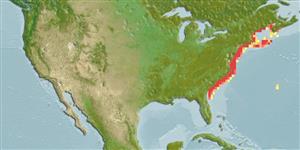>
Clupeiformes (Herrings) >
Alosidae (Shads and Sardines)
Etymology: Brevoortia: From James Carson Brevoort (1818-1887), studie the fauna from Ohio and South Caroline (Ref. 45335).
Environment: milieu / climate zone / depth range / distribution range
Ecologia
marinhas; estuarina ; pH range: 1.0 - 36.0; oceanódromo (Ref. 51243); intervalo de profundidade 0 - 50 m (Ref. 188). Subtropical; ? - 26°C (Ref. 38970); 46°N - 30°N, 81°W - 64°W (Ref. 54290)
Western Atlantic: Nova Scotia, Canada southward to Indian River, Florida, USA.
Comprimento de primeira maturação / Tamanho / Peso / Idade
Maturity: Lm 25.0, range 18 - 32 cm
Max length : 50.0 cm TL macho/indeterminado; (Ref. 188)
Espinhos dorsais (total) : 0; Raios dorsais (total) : 18 - 24; Espinhos anais: 0; Raios anais : 18 - 24. Upper jaw with median notch. Pelvic fin with rounded hind margin, inner fin rays equal or nearly equal to outer fin rays when fin folded back. Pre-dorsal scales modified; scales on back, above base of anal fin and at base of tail much smaller and irregularly placed. A black spot behind gill opening, followed along flank by approximately 6 lines of smaller spots (Ref. 188). Silvery, with brassy sides and a dark bluish green back (Ref. 7251).
Found inshore in summer, but at least some moving into deeper water in winter. Adults are found in near surface waters (Ref. 38984), usually in shallow areas overlying continental shelf, in greatest abundance immediately adjacent to major estuaries (Ref. 4639). Juveniles are also generally pelagic, with smallest size groups farthest up river (Ref. 38986). Form large and very compact schools, both of juveniles and adults. Migrate north - south; also in and out of bays and inlets. Feed by filtering phytoplankton (diatoms (Ref. 5951)) and zooplankton (small crustaceans, annelid worms and detritus (Ref. 5951)). High water temperatures apparently limit breeding. Spawn probably all year; nursery areas in estuaries. Larvae are pelagic (Ref. 38985), probably spend about a month in waters over continental shelf (Ref. 38983), entering estuarine waters at about 10 mm and larger (Ref. 844). Marketed fresh, salted, canned or smoked. Mainly used for production of oil, fertilizer and fishmeal (Ref. 188). Parasites found are isopods, copepod, cestodes and trematodes (Ref. 37032).
Breeding season apparently limited by high water temperatures (20.5°C monthly mean maximum). Spawning activity occurring almost every month in some part of the range (Ref. 2472, 39013, 844). Spawning temperature ranges from 4.4°C to 23.6°C, with peak activity at 15-18°C (Ref. 39014). Salinity ranges from 10 ppt (Ref. 39015) to usually greater than 25 ppt (Ref. 844). Fecundity observed is from 38,000 to 631,000 eggs per season (Ref. 39013).
Whitehead, P.J.P., 1985. FAO Species Catalogue. Vol. 7. Clupeoid fishes of the world (suborder Clupeoidei). An annotated and illustrated catalogue of the herrings, sardines, pilchards, sprats, shads, anchovies and wolf-herrings. FAO Fish. Synop. 125(7/1):1-303. Rome: FAO. (Ref. 188)
Status na Lista Vermelha da UICN (Ref. 130435)
Ameaça para os humanos
Harmless
Uso pelos humanos
Pescarias: altamente comercial
Ferramentas
Relatórios especiais
Baixar XML
Fontes da internet
Estimates based on models
Preferred temperature (Ref.
123201): 7.5 - 24.4, mean 13.2 °C (based on 120 cells).
Índice de diversidade filogenética (Ref.
82804): PD
50 = 0.5156 [Uniqueness, from 0.5 = low to 2.0 = high].
Bayesian length-weight: a=0.01000 (0.00534 - 0.01873), b=3.10 (2.94 - 3.26), in cm total length, based on LWR estimates for this species & Genus-body shape (Ref.
93245).
Nível Trófico (Ref.
69278): 3.2 ±0.2 se; based on diet studies.
Generation time: 2.8 (2.4 - 3.6) years. Estimated as median ln(3)/K based on 38
growth studies.
Resiliência (Ref.
120179): médio(a), tempo mínimo de duplicação da população 1,4 - 4,4 anos (K=0.4; tm=1-3; Fec=38,000).
Prior r = 0.31, 95% CL = 0.20 - 0.46, Based on 1 data-limited stock assessment.
Fishing Vulnerability (Ref.
59153): Low to moderate vulnerability (30 of 100).
Climate Vulnerability (Ref.
125649): Moderate vulnerability (45 of 100).
Nutrients (Ref.
124155): Calcium = 87.7 [51.9, 140.0] mg/100g; Iron = 1.45 [0.83, 2.30] mg/100g; Protein = 20 [19, 21] %; Omega3 = 0.58 [0.35, 0.93] g/100g; Selenium = 21.6 [11.4, 40.2] μg/100g; VitaminA = 8.6 [3.6, 21.0] μg/100g; Zinc = 0.964 [0.676, 1.343] mg/100g (wet weight);
